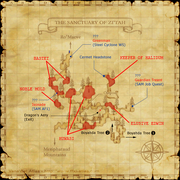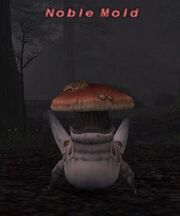(cleanup / partial revert / additional spawn information / drop rate (1/4)) |
No edit summary |
||
| Line 14: | Line 14: | ||
|align="center"| 50 |
|align="center"| 50 |
||
| |
| |
||
| − | *[[Rain Hat]] {{Drop Rate| |
+ | *[[Rain Hat]] {{Drop Rate|16|42}} |
| |
| |
||
|align="center"| 1 |
|align="center"| 1 |
||
Revision as of 14:13, 7 January 2010
|
|
| Zone | Level | Drops | Steal | Spawns | Notes |
|---|---|---|---|---|---|
| The Sanctuary of Zi'Tah | 50 | 1 | A, L ~4,400 HP, ??? MP | ||
|
HP = Detects Low HP; M = Detects Magic; Sc = Follows by Scent; T(S) = True-sight; T(H) = True-hearing JA = Detects job abilities; WS = Detects weaponskills; Z(D) = Asleep in Daytime; Z(N) = Asleep at Nighttime; A(R) = Aggressive to Reive participants | |||||

Spawns at the south end of (E-9).
Notes
- Morphs from one the two Myxomycetes at the south end of (E-9) after approximately 19-25 hours. Will only morph during rainy weather.
- Unlike Lottery Spawn monsters, the placeholder for Noble Mold must remain alive in order for Noble Mold to spawn. Killing the placeholder resets the spawn timer the same way killing Noble Mold does. Maintenance will also reset the spawn timer.
- The true placeholder appears as the last Myxomycete on Wide Scan.
- Can spawn at any time during rainy weather. Will not despawn if the weather changes, even if left alone.
- Rainy weather in this area occurs mostly from the 4th Vana'diel month through the 6th month. Most recorded spawns of Noble Mold have occurred in months 5 and 6. The Weather Reporters in Jeuno and Mhaura will specifically predict "Rain" during this period, usually for all three forcasted days.
- Assuming Noble Mold will only spawn during this "rainy season," you can expect a 2-3 day window (Earth time) within a 2-week period for Noble Mold to spawn. It is possible for it to spawn multiple times during this period.
- Contrary to some early theories, Noble Mold can spawn any day of the Vana'diel week.
Historical Background
Noble Rot (also called Botrytis Bunch Rot, Pourriture noble, Edelfäule) is the common name of the mold Botrytis cinerea. It is a gray fungus which is known for its infections of grapes, which in some circumstances can produce a more flavorful wine... or destroy much of a season's crop. The right conditions for it to appear tend to be rare and it is a very valued fungus in viticulture. It produces 2 different infections: the gray rot (occurs in continual humid or wet conditions, causes afflicted grape bunches to decay) and the noble rot (occurs when wet conditions are followed by dry conditions, causes afflicted grapes to develop a very distinct sweet taste). The noble rot requires specific conditions in a specific sequence to form: a short period of humidity or rain mid to late in the growing season when grapes are more ripe followed by sustained cool, dry weather with daytime temperatures ~60°F. The change in taste occurs because the fungus siphons water from the grapes, resulting in a higher percentage of solids inside the grape, producing a more concentrated taste inside the grapes. This works primarily for the white grape varieties (Sauternes, Tröckenbeerenauslese, Tokaji, Semillion, Sauvignon, Amarone, Ausbruch, Cotnari, Riesling, Furmint). The mold inhibits fermentation inside the grapes by producing yeasticides. The afflicted grapes must undergo additional fermentation in vats spanning months and processing the grapes into wine is more labored and involved with the afflicted grapes due to the low amount of juices inside them. The end result is exquisite wine, but only a small quantity of it and which needed extensive processing to produce (thus it tends to be expensive). Wine resulting from the noble mold infection is said to "have an aroma of honeysuckle and a bitter finish on the palate". It is the lengthy fermentation which produces the exceptional fragrance of the wine. It can also infect strawberries, but has no resulting improvements in flavor. Infected strawberries must be destroyed.
The unusual spawn conditions of Noble Mold were probably inspired by the Noble Rot's rare sequence of weather conditions required to produce the desired infection of grapes.

